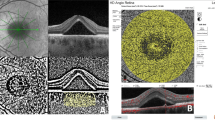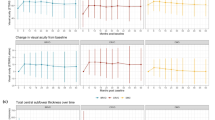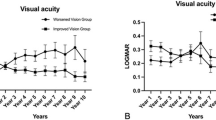Abstract
Aim
To evaluate the effectiveness of combined lasers with different wavelengths in creating chorioretinal venous anastomosis (CRVA) in nonischaemic central retinal vein occlusion (CRVO).
Methods
In this retrospective, noncomparative, consecutive case series, records of all patients with a diagnosis of nonischaemic CRVO who underwent combined laser treatment to induce CRVA and who were followed-up for 6 months or longer were reviewed.
Results
Records of 85 patients (85 eyes) were analysed. These patients were divided into two groups. In group 1 (24 cases, 24 eyes), combined lasers with two different wavelengths (argon blue–green laser combined with Nd–YAG laser were used. In group 2 (61 cases, 61 eyes), combined lasers with three different wavelengths (argon blue–green laser combined with krypton red laser and Nd–YAG laser) were used. Functional anastomosis formed in 13 out of 24 eyes (54%) in group 1 and 47 out of 61 eyes (77%) in group 2. In patients with successful anastomosis, visual acuity improved for two or more lines in 49 out of 60 eyes (82%), with the remaining eyes undergoing no change. There were no serious complications.
Conclusion
The use of three laser wavelengths results in the creation of laser anastomosis and the success rate may be higher than when using two wavelengths alone.
Similar content being viewed by others
Log in or create a free account to read this content
Gain free access to this article, as well as selected content from this journal and more on nature.com
or
References
McAllister IL, Douglas JP, Constable IJ, Yu DY . Laser-induced chorioretinal venous anastomosis for nonischaemic central retinal vein occlusion: evaluation of the complications and their risk factors. Am J Ophthalmol 1998; 126: 219–229.
Fekrat S, Goldberg MF, Finkelstein D . Laser-induced chorioretinal venous anastamosis for nonischaemic vein occlusion. Arch Ophthalmol 1998; 116: 43–52.
Browning DJ, Antoszyk AN . Laser chorioretinal venous anastomosis for nonischaemic central retinal vein occlusion. Ophthalmology 1998; 105: 670–679.
Browning DJ, Rotberg MH . Vitreous haemorrhage complicating laser-induced chorioretinal anastomosis for central retinal vein occlusion. Am J Ophthalmol 1996; 122: 588–589.
Eccarius SG, Moran MJ, Siingsby JG . Choroidal neovascular membrane after laser-induced chorioretinal anastomosis. Am J Ophthalmol 1996; 122: 590–591.
Jeffrey KL . Epiretinal membrane and traction retinal detachment complicating laser-induced chorioretinal venous anastomosis. Am J Ophthalmol 1997; 123: 698–699.
Central Vein Occlusion Study Group. Baseline and early natural history report: the central vein occlusion study. Arch Ophthalmol 1993; 111: 1087–1095.
Goldberg MF . Chorioretinal vascular anastomosis after blunt trauma to the eye. Am J Ophthalmol 1978; 85: 171–173.
Vijayasekaran S, Yu DY, McAllister I, Barry C, Constable I . Optimal conditions required for the creation of an iatrogenic chorioretinal venous anastomosis in the dog using argon green laser photocoagulation. Curr Eye Res 1995; 14: 63–70.
Marshall J, Bird AC . A comparative histopathological study of argon and krypton laser of the human retina. Br J Ophthalmol 1979; 63: 657–668.
Koizumi K, Nishiura M, Yamamoto T, Mchida T, Nakamura T, Ouchi M et al. Intentional complete interruption of a retinal vein after vitrectomy might improve the rate of successful chorioretinal venous anastomosis formation in central retinal vein occlusion. Graefes Arch Clin Exp Ophthalmol 2002; 240: 787–794.
Leonard BC, Coupland SG, Kertes PJ, Bate R . Long-term follow-up of a modified technique for laser-induced chorioretinal venous anastomosis in nonischaemic central retinal vein occlusion. Ophthalmology 2003; 110: 948–954.
The Central Vein Occludon Study Group. Natural history and clinical management of central retinal vein occlusion. Arch Ophthalmol 1997; 115: 486–491.
Author information
Authors and Affiliations
Corresponding author
Additional information
Ethic approval: Beijing Committee Review Board approval was obtained at the beginning of the study. The location of the Committee Review Board is Beijing Health Bureau
Competing interest statement: There are no proprietary or commercial interests
Previous presentation: This study was partly presented in the First Seri-ARVO meeting on research in vision and ophthalmology in Singapore in 2003, hosted by Singapore Eye Research Institute and ARVO
Rights and permissions
About this article
Cite this article
Lu, N., Wang, N., Li, Z. et al. Laser-induced chorioretinal venous anastomosis using combined lasers with different wavelengths. Eye 21, 962–967 (2007). https://doi.org/10.1038/sj.eye.6702362
Received:
Revised:
Accepted:
Published:
Issue date:
DOI: https://doi.org/10.1038/sj.eye.6702362



